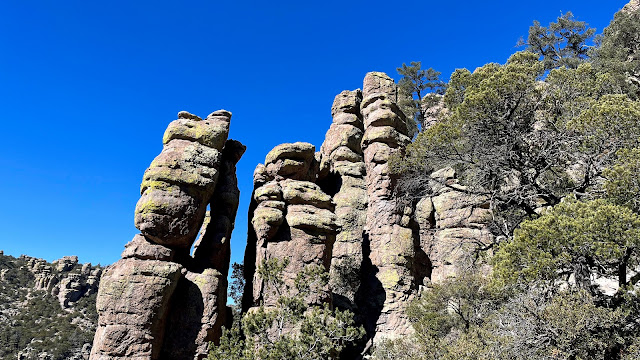Today is the last real hike of the season, real for us meaning not a stroll on a flat trail shorter than eight miles. The Bug Springs Trail turned out to be a bit of a workout, but getting the blood moving was essential with trailhead temps in the high thirties. And the first 2 miles or so were pretty much all up hill—to the tune of over 1,400 feet of elevation gain. This trail is in the eastern end of the Santa Catalinas, about twelve miles up the Catalina Highway on Mount Lemmon. The last hike we started off this highway was earlier this year when Misty and I hiked the wonderful Soldier Trail. And three years ago, four of us would ride our bikes all 26 miles up to the summit of Mount Lemmon for the thrilling and frightful 40-mph descent. Maybe once is enough for that journey, not only because of the insane descent, but done as it was on a heavy 30-year-old Klein mountain bike with shocks that don't lock out.
Glad we hit the trail early today (7:30) as we avoided other bipeds until the last couple of miles from the end. Temps were in the sixties when we returned to the trailhead after three and a half hours.
The Bug Springs Trail has some interesting and varied ecology and geology. We started out on a pretty smooth trail punctuated by the occasional boulder scramble. After the ascent to the first saddle, we climbed down into the canyon and through a wonderful forest of oaks, aspens, and fir trees—on any other hike or later in the day a welcomed respite from the heat, but today, we pushed the pace to get back into the sun.
The geology was also somewhat varied today, but this trail is known for its rock outcroppings and spires. Who knew hoodoos would feature in two consecutive hikes—and hoodoos of completely different origin. The hoodoos on Mount Lemmon are primarily metamorphic, and primarily gneiss; the hoodoos from last week's hike in the Chiricahuas are mostly extrusive igneous rhyolite rocks, the result of extreme volcanic activity. In both cases, the shapes of these columns of stone are formed over millions of years through the processes of erosion common to these arid climates: freezing and cracking in the winter, and the slow abrasion of wind and water across geologic time.
 |
Much of the trail, but especially the ridges, was forgiving sand and gravel. My feet thank you, Bug Springs Trail.
|
 |
Misty with her usual sun-drenched smile.
|
 |
Scar of a prior fire, not the horrific blaze of 2020, which burned over 120,000 acres in the Catalinas.
|
 |
A look toward the forested canyon down into which we would shortly descend.
|
 |
Pushing the limits of my iPhone's telephoto function.
|
 |
About two miles and half an hour from the end of the hike. (Photo by Misty Atkins)
|
 |
Gneiss shot.
|



























































